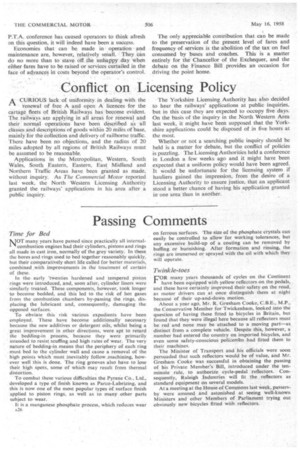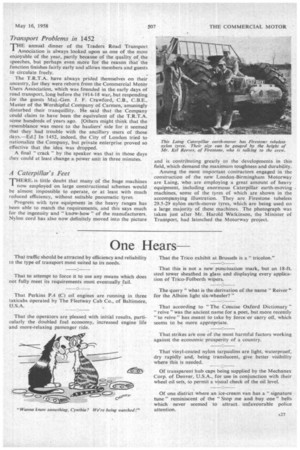Passing Comments
Page 28

Page 29

If you've noticed an error in this article please click here to report it so we can fix it.
Time for Bed
MOT many years have passed since practically all internal" combustion engines had their cylinders, pistons and rings all made in cast iron, normally of the grey variety. In these the bores and rings used to bed together reasonably quickly, but their comparatively short life called for better materials, combined with improvements in the treatment of certain of these.
In the early 'twenties hardened and tempered piston rings were introduced, and, soon after, cylinder liners were similarly treated. These components, however, took longer to become bedded, and this led to the risk of hot gases from the combustion chambers by-passing the rings, displacing the lubricant and, consequently, damaging the opposed surfaces.
To obviate this risk various expedients have been employed. These have become additionally necessary because the new additives or detergent oils, whilst being a great improvement in other directions, were apt to retard the bedding-in process, because they were primarily intended to resist scuffing and high rates of wear. The very nature of bedding-in means that the periphery of each ring must bed to the cylinder wall and cause a removal of the high points which must inevitably follow inachining, however well this is done. The ring grooves also have to lose their high spots, some of which may result from thermal distortion.
To combat these various difficulties the Pyrene Co., Ltd., developed a type of finish known as Pareo-Lubrizing, and this is now one of the most popular types of surface finish applied to piston rings, as well as to many other parts subject to wear.
It is a manganese phosphate process, which reduces wear A26 on ferrous surfaces. The size of the phosphate crystals can easily be controlled to allow for working tolerances, but any excessive build-up of a coating can be removed by buffing or burnishing. After formation and rinsing, the rings are immersed or sprayed with the oil with which they will operate.
Twinkle-toes
FOR many years thousands of cycles on the Continent have been equipped with yellow reflectors on the pedals, and these have certainly improved their safety on the road, as motor drivers can at once distinguish them at night because of their up-and-down motion.
About a year ago, Mr. R. Gresham Cooke, C.B.E., the Conservative Member for Twickenham, looked into the question of having these fitted to bicycles in Britain, but found that they were illegal here because all reflectors must be red and none may be attached to a moving part—as. distinct from a complete vehicle. Despite this, however, a number had entered the country on imported bicycles, and even some safety-conscious policerrfen had fitted them to their machines.
The Minister of Transport and his officials were soon persuaded that such reflectors would be of value, and Mr. Gresham Cooke was successful in obtaining the passing of his Private Member's Bill, introduced under the tenminute rule, to authorize cycle-pedal reflectors. Consequently, Raleigh Industries will fit the reflectors as
standard equipment on several models. • At a meeting at the House of Commons last week, passersby were amused and astonished at seeing well-known Ministers and other Members of .Parliament trying out obviously new bicycles fitted with reflectors.
Transport Problems in 1452 THE annual dinner of the Traders Road Transport
Association is always looked upon as one of the most enjoyable of the year, partly because of the quality of the speeches, but perhaps even more for the reason that the function finishes fairly early and allows members and guests to circulate freely.
The T.R.T.A. have always prided themselves on their ancestry, for they were reborn from the Commercial Motor Users Association, which was founded in the early days of road transport, long before the 1914-18 war, but responding for the guests Maj.-Gen. J. F. Crawford, C.B., C.B.E., Master of the Worshipful Company of Carmen, amusingly disturbed their tranquillity. He said that the Company could claim to have been the equivalent of the T.R.T.A. some hundreds of years ago. [Others might think that the resemblance was more to the hauliers' side for it seemed that they had trouble with the ancillary users of those days.—Ed.] In 1452, indeed, the City of London tried to nationalize the Company, but private enterprise proved so effective that the idea was dropped.
A final " crack " by the speaker was that in those days they could at least change a power unit in three minutes.
A Caterpillar's Feet
THERE, is little doubt that many of the huge machines I now employed on large constructional schemes would be almost impossible to operate, or at least with much reduced efficiency, without suitable pneumatic tyres. Progress with tyre equipment in the heavy ranges has been able to match the requirements, and this says much for the ingenuity and " know-how " of the manufacturers. Nylon cord has also now definitely moved into the picture and is contributing greatly to the developments in this field, which demand the maximum toughness and durability.
Among the most important contractors engaged in the construction of the new London-Birmingham Motorway are Laing, who are employing a great amount of heavy equipment, including enormous Caterpillar earth-moving machines, some of the tyres of which are shown in the accompanying illustration. They are Firestone tubeless 29.5-29 nylon earth-mover tyres, which are being used on a large majority of these machines. The photograph was taken just after Mr. Harold Watkinson, the Minister of Transport, had launched the Motorway project.




































































































